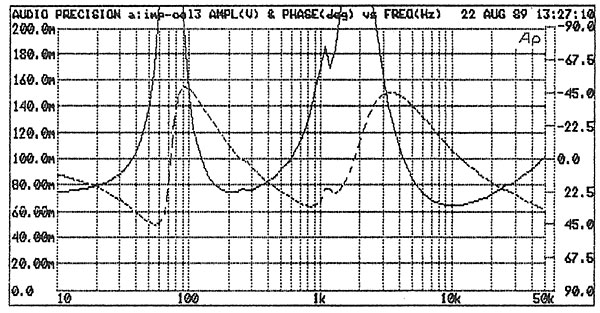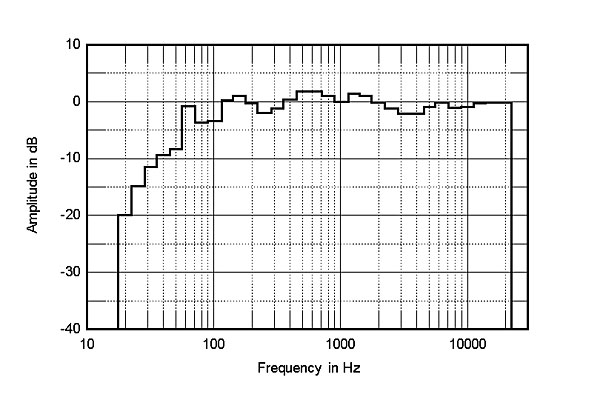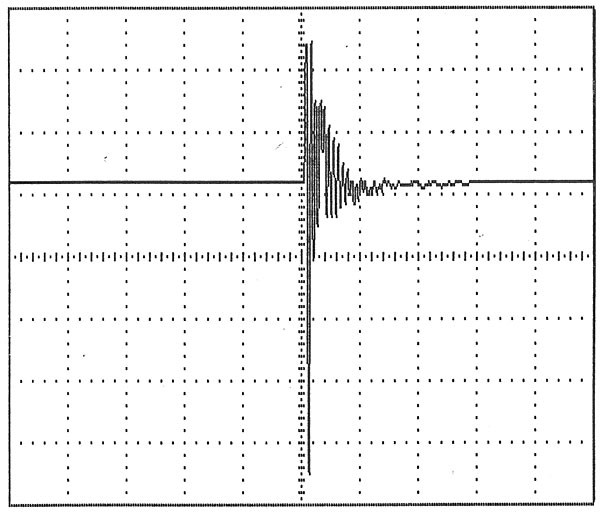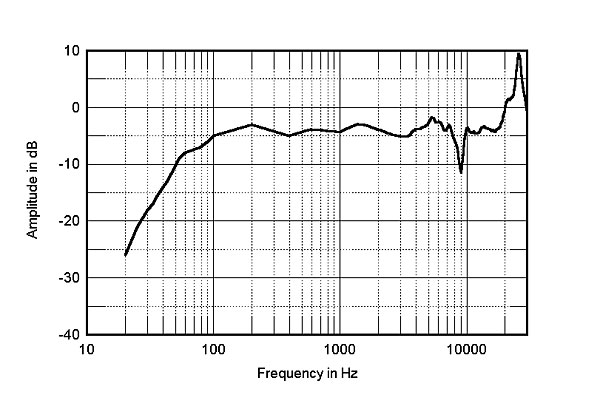| Columns Retired Columns & Blogs |
That's not a Celestion 3 in the photo...
The Celestion 3's impedance phase (dotted line) and magnitude (solid line) are shown in fig.1. [Note that the phase scale is the opposite way around from what the magazine adopted in 1991, with negative (capacitive) angles at the top.—Ed.] The peak in the bass due to the woofer's sealed-box loading reaches a maximum of 46 ohms at 72Hz. Overall, putting its low sensitivity to one side, the 3 will be easy to drive, the impedance only dropping below 8 ohms in the upper bass and mid-treble. The slight wrinkle seen at 250Hz is probably a cabinet effect, the cabinet sidewalls feeling very lively in the entire 200–400Hz region with a very strong resonant mode obvious at 310Hz. It's harder to say, however, what the kink in both magnitude and phase responses at approximately 1200Hz represents. Perhaps it is the fundamental tweeter resonance superimposed on the rise in impedance due to the second-order high-pass filter, but as a response peak appears at the same frequency on both the in-room and FFT measurements and could be heard, it may be a woofer artifact after all.

Moving on to the spatially averaged, in-room response (fig.2), this was taken with the 3s out in the room rather than up against the rear wall where the serious auditioning was done. Although rolling off early in the upper bass, the rate of roll-out, as with the Spica, is gentle compared with typical reflex designs. Assessed in the nearfield, the –6dB point is a reasonably low 45Hz, which better correlates with the subjective extension when the speaker is placed against the rear wall.

Fig.2 shows some liveliness in the midrange, particularly, as mentioned above, in the 1250Hz region, but then with a remarkably even response trend throughout the treble, apart from a slight energy lack in the crossover region due to suckouts in this area developing both above and below the optimum axis. (The individual measurements taken to compile fig.2 reveal excellent pair-matching for such an inexpensive loudspeaker.)
The impulse response on the tweeter axis in fig.3 (0.5ms/division) is not particularly time-coherent and reveals the tweeter and woofer to be connected with opposite polarity. It is overlaid with ultrasonic ringing from the metal-dome tweeter . If you are worried by this ringing, as the resonance is of high Q, though excited by transients, it will not be excited by music with a normal spectral content. (As a rule of thumb, a resonance needs to be hit with its own frequency for a sustained number of cycles equal to its Q for the ringing to develop to its maximum. A resonance at 1kHz with a Q of 1000 therefore needs to be excited for 1000 cycles—ie, one second—to be fully excited. In addition, the higher the Q, the more critical it is that the exciting signal have the same frequency as the resonance if it is to make it ring at all. This is why low-Q resonances typical of loudspeaker enclosures are so pernicious. They will be excited continually by music that has content anywhere near their resonant frequency and will add a continual background of subjective "mud." High-Q resonances, typical of metal-dome tweeters, will ring at their ultrasonic frequency on transients, but it is debatable whether that produces audible effects downband.)

Looking at the FFT-derived anechoic response of the 3 (fig.4), this was plotted with 200Hz resolution to get sufficient bandwidth to reveal the frequency of the primary tweeter resonance, which can be seen to produce a peak almost 10dB high at 25.6kHz. I suspect that the slight peak at 21.1kHz is a measurement artifact rather than a real attribute of the speaker, due to aliasing between the main resonance and the 'scope's sampling frequency. Upon reflection, however, the actual frequencies are not quite right, so the matter remains in doubt. The response is a little ragged in the upper region of the tweeter's passband, with a narrow suckout apparent on all axes centered on 9kHz. Repeating the FFT analysis with a 100Hz bandwidth reveals quite a narrow on-axis peak centered on 1370Hz only hinted at in fig.4, this increasing in height below the listening axis. In fact, putting the Celestion 3s on high shelves or stands is not to be recommended, as both treble and midrange then appear to become significantly lumpy.—John Atkinson

